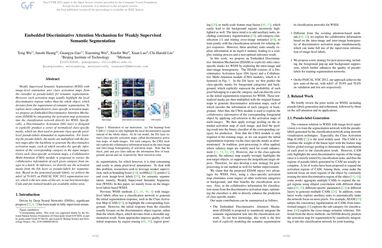Embedded Discriminative Attention Mechanism for Weakly Supervised Semantic Segmentation
Weakly Supervised Semantic Segmentation (WSSS) with image-level annotation uses class activation maps from the classifier as pseudo-labels for semantic segmentation. However, such activation maps usually highlight the local discriminative regions rather than the whole object, which deviates from the requirement of semantic segmentation. To explore more comprehensive class-specific activation maps, we propose an Embedded Discriminative Attention Mechanism (EDAM) by integrating the activation map generation into the classification network directly for WSSS. Specifically, a Discriminative Activation (DA) layer is designed to explicitly produce a series of normalized class-specific masks, which are then used to generate class-specific pixel-level pseudo-labels demanded in segmentation. For learning the pseudo-labels, the masks are multiplied with the feature maps after the backbone to generate the discriminative activation maps, each of which encodes the specific information of the corresponding category in the input images. Given such class-specific activation maps, a Collaborative Multi-Attention (CMA) module is proposed to extract the collaborative information of each given category from images in a batch. In inference, we directly use the activation masks from the DA layer as pseudo-labels for segmentation. Based on the generated pseudo-labels, we achieve the mIoU of 70:60% on PASCAL VOC 2012 segmentation test set, which is the new state-of-the-art, to our best knowledge. Code and pre-trained models are available online soon.
PDF Abstract




 ImageNet
ImageNet
 Caltech-256
Caltech-256
 VOC 2012
VOC 2012